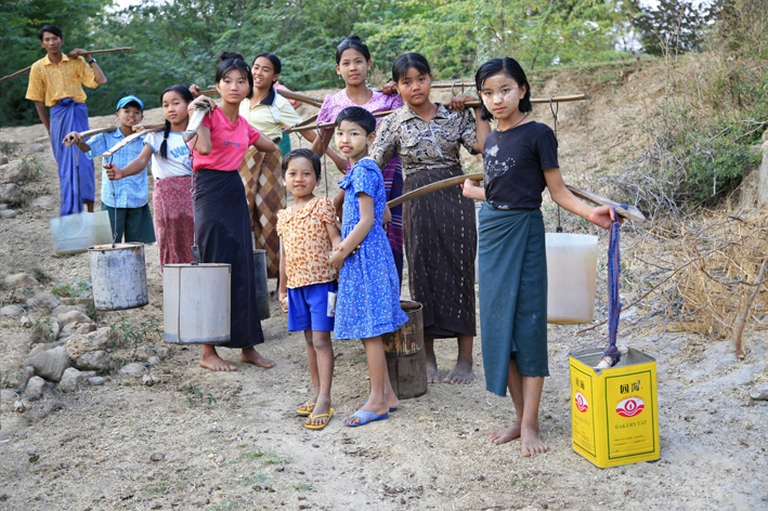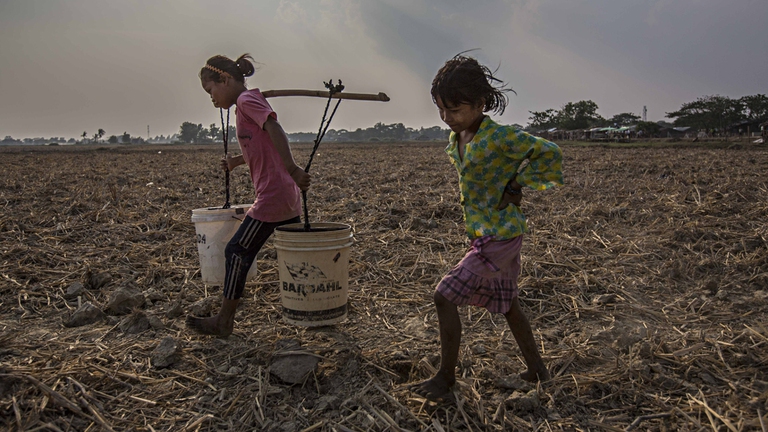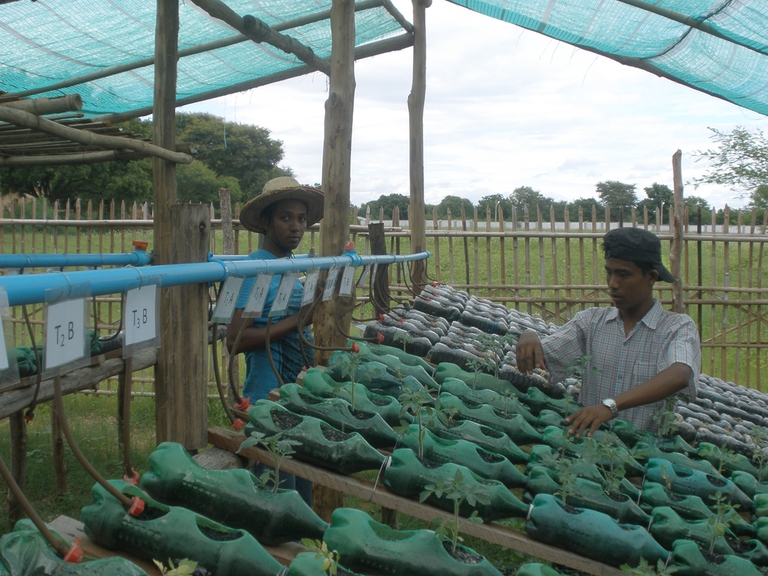
After a landslide led to twelve deaths on the island of Ischia, questions have been raised about the impacts of illegal building, tourism, and climate change.
Come le famiglie di una delle aree più aride del Myanmar coltivano gli ortaggi utilizzando sistemi che usano l’acqua in modo efficiente, risparmiandola. Tra questi c’è anche un progetto di Terres des Hommes Italia.
Myo Myint fondly remembers when his one-acre farm regularly produced 100 baskets of rice. But as rainfall became erratic in this arid region, he started growing betel leaves, a less thirsty cash crop. This summer, the 50-year-old is considering leaving fallow his land in Myanmar’s central Dry Zone because when the stream behind his house dries up in March, the cost of irrigation outstrips the income from any crop.
A 2016 drought followed by heavy rains already battered his farm. “Water is becoming more scarce every year. I want to keep growing the crops but there’s not much I can do without water,” he said, sitting beneath the ground floor of his stilt house. His village of Myay Ni Twin, in Pakokku township, is around two hours’ drive from Bagan, Myanmar’s top tourist destination known for its ancient Buddhist temples. “When I was growing up, the stream didn’t go dry. Now there’s less rain, and it’s very hard to plant things,” he said.
Myanmar recently emerged from decades of military dictatorship only to face a bigger existential threat. The Southeast Asian nation of 50 million people is the world’s second most vulnerable country to climate change, according to the Global Climate Risk Index from research group Germanwatch. Studies have shown the onset of the monsoon is becoming more variable, increasing the risk of drought.
The Dry Zone, an area comprising 58 townships in Mandalay, Magwe and Sagaing, is home to around 10 million people who mostly rely on rain-fed agriculture. It suffers from year-round water shortages.
A recent assessment by the Myanmar Climate Change Alliance (MCCA), an initiative funded by the European Union and United Nations, predicted a temperature increase of up to 3 degrees Celsius and a shorter monsoon in Pakokku by 2050. Farmers like Myo Myint – already struggling to make ends meet – will bear the brunt of those changes. His village has a well, but pumping water costs too much, he said. So he was intrigued by the prototypes of soil moisture sensors in the hands of Tayzar Lin, a product designer with Proximity Designs, a Myanmar-based social enterprise that develops affordable products for farmers.
“I’ve been curious since I saw something similar on Facebook,” said the farmer, as Tayzar Lin plunged into the soil a boxy contraption with a dial at the top and an alloy-tipped brass rod at the bottom. The hand on the dial moved to green, showing the soil still held water. Red means dry, and blue means too much water. Myo Myint dreams of watering only when needed, instead of every two days as he now does, to save the precious resource.
Agriculture – including livestock, fisheries and forestry – contributes nearly 40 per cent of Myanmar’s GDP and employs around half its workforce, according to Andrew Kirkwood, director of the Livelihoods and Food Security Trust Fund (LIFT), a poverty reduction fund supported by 12 governments. “Agriculture is extremely important to Myanmar’s economy and future growth,” he said.
A 2013 study funded by LIFT identified the Dry Zone as Myanmar’s most water-stressed region and one of its most food-insecure areas. Inexpensive water sensors made abroad are already available, but their instructions are in English and they are not widely used, nor calibrated by soil type. Proximity Designs’ sensor works with loam and clay, and its staff will train farmers to use it properly, the firm said.
The device – expected to retail at an affordable price of around 30,000 kyat (22 dollars) – is now being tested in three Dry Zone townships, said Proximity’s user research manager Louisa-Jane Richards. A study of growers of flowers, vegetables and betel – a mild stimulant that is chewed – found they were over-irrigating by around 30 per cent, she said. Cutting that to 15 per cent could save a farmer with 0.2 hectares around 765 litres of water a season.
Families in the Dry Zone are also getting help to grow nutritious food in gardens using drip irrigation and hydroponics. Non-profit Terre des Hommes (TdH) Italy has set these up in 45 villages with funding from LIFT.
Shwe Bon Thar, a dusty village in Myingyan township, shares a pond with five other villages. But when its water disappears in the dry season, locals must rely on acidic well water and fresh vegetables become pricey. Maung Maung, 46, now makes 1,000 kyat a day selling mint from the hydroponic garden behind his house, a 3-metre by 2-metre plot of vivid green surrounded by sandy soil. The gravity-fed system irrigates leafy vegetables in discarded water bottles while leftover water collected at the bottom is recycled. Maung Maung, who uses almost 19 litres of water a day, also grows mustard leaves, morning glory and lettuce, which go into the family meal. “We used to eat vegetables only when we could afford it, about three times a week. Now we eat fresh, pesticide-free vegetables every day,” he said.
The extra income from selling his surplus produce will help in the coming dry months. Like many villagers, his main crop is pigeon pea, whose price has plummeted this year.
Beyond immediate food and water needs, the Dry Zone is also experiencing dramatic shifts. In many villages, most farmers are in their forties and fifties, as young people have left. Maung Maung’s three adult children work at factories in Mandalay, Myanmar’s second-biggest city.
Pasquale Capizzi, MCCA’s chief technical advisor, said Myanmar needed to tackle both immediate natural disasters and the more gradual impacts of climate change. “Response… must involve society as a whole”, encompassing local and national government, businesses, communities and civil society”, he said. “You must adapt with different crops, different agricultural techniques, different mechanisation and productivity improvement – but in some areas you may have to be prepared to learn another trade,” he said. Climate change will intensify risks such as cyclones, floods and droughts, he added, but will also have “silent effects” on soil salinity, health and yields. People’s efforts to adapt, said Capizzi, must be supported to reinforce “the innate resilience of communities not to accept fate, but to bounce back and improve”.
Siamo anche su WhatsApp. Segui il canale ufficiale LifeGate per restare aggiornata, aggiornato sulle ultime notizie e sulle nostre attività.
![]()
Quest'opera è distribuita con Licenza Creative Commons Attribuzione - Non commerciale - Non opere derivate 4.0 Internazionale.
After a landslide led to twelve deaths on the island of Ischia, questions have been raised about the impacts of illegal building, tourism, and climate change.
Not much snow, peaks of 19 degrees Celsius in Norway and even 28 degrees in France: official data confirms the anomalously high temperatures of this past winter.
Ocean warming has risen to record highs over the last five years: just in 2019 the heat released into the world’s oceans was equivalent to that of 5-6 atomic bombs per second. The culprit, no doubt, is climate change.
What did Greta Thunberg tell participants at the 2020 World Economic Forum in Davos? Once again, the Swedish activist underlined the total lack of concrete solutions to the climate crisis presented by leaders so far.
The list of human and animal victims of the Australia wildfires keeps growing – one species might already have gone extinct – as the smoke even reaches South America.
Kivalina is located on a small island once guarded by sea ice, which is now melting due to global warming. While the sea threatens to wipe the village off the face of the Earth, its inhabitants refuse to give up their lives and traditions.
Thanks to activists, the voice of the world’s peoples resounded through the COP25 like an alarm bell. Governments didn’t reach the results they demanded, but their cries and messages were stronger than ever, reaching even those who weren’t in Madrid.
Climate change poses a risk for millions. However, women are the most vulnerable to its negative consequences: a few simple considerations by the Italian Climate Network help us perceive the global implications of this.
The COP25 ended two days late and with very few steps ahead made. Climate negotiations in 2020 will be an uphill battle as political will clearly seems to be lacking, once again.











